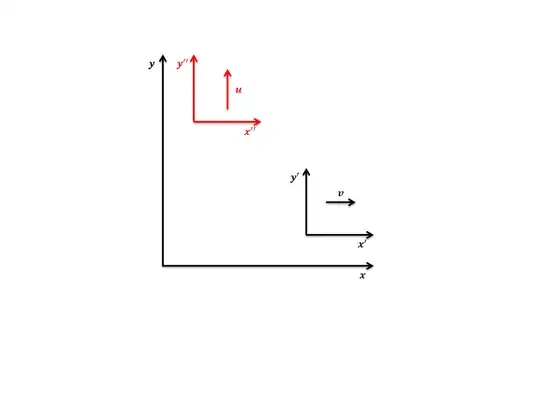According to the first postulate of relativity, physics laws (formulae) keep their mathematical form from one reference frame to another with a relative velocity, meaning that the following equations can be written in the primed in terms of the unprimed values: [see the figure] $$x'=\gamma_v (x-vt),\space\space y'=y, \space\space t'=\gamma_v (t-vx/c^2)$$ where $\gamma_v=1/\sqrt{1-v^2/c^2}$. Now, if we want to obtain the relevant equations in the unprimed system, and according to the SR first postulate, it suffices to replace any unprimed values with their primed counterpart and vice versa and also change $v$ to $-v$ since the direction of velocity is opposite as measured in each frame. Therefore, we have: $$x=\gamma_v (x'+vt'),\space\space y=y', \space\space t=\gamma_v (t'+vx'/c^2)$$ Now, assume a third frame of reference (double primed system colored red) moving at $u$ along the $y$-axis relative to the unprimed system. It is evident that the following equations are valid: [see the figure] $$x''=x,\space\space y''=\gamma_u (y-ut), \space\space t''=\gamma_u (t-uy/c^2)$$ where $\gamma_u=1/\sqrt{1-u^2/c^2}$. Again, if we want to obtain the relevant equations in the unprimed system, and according to the SR first postulate, it suffices to replace any unprimed values with their double primed counterparts and vice versa and also change $u$ to $-u$ since the direction of velocity is opposite as measured in each frame. Therefore, we have: $$x=x'',\space\space y=\gamma_u (y''+ut''), \space\space t=\gamma_u (t''+uy''/c^2)$$ However, if we decide to connect the primed system to the double primed one by eliminating the unprimed values, we get: $$x'=\gamma_v x''-v\gamma_v \gamma_u (t''+uy''/c^2),\space\space y'=\gamma_u (y''+ut''), \space\space t'=\gamma_v \gamma_u (t''+uy''/c^2)-v\gamma_v x''/c^2$$ According to Einstein's first postulate, we anticipate that the equations in the double primed system can be obtained by replacing the primed values with their double primed counterpart and vice versa and changing $u$ to $-u$ and $v$ to $-v$. However, this is amazingly not the case! Indeed, the equations in the double primed system are as follows: $$x''=\gamma_v (x'+vt'),\space\space y''=\gamma_u y'-u\gamma_v \gamma_u (t'+vx'/c^2), \space\space t''=\gamma_v \gamma_u (t'+vx'/c^2)-u\gamma_u y'/c^2$$ Remember that I know that the result of two successive boosts is not a pure boost but a boost accompanied by a (Wigner) rotation. However, it seems that the two last groups of equations are not in agreement with Einstein's first postulate, meaning that the mathematical forms are not invariant in some cases. Am I not right?!
Update #1: One may say that there is a difference between physical laws and coordinate transformations. It is worth mentioning that $x=vt$ is a simple physical law that indicates the spatial position of a particle (moving at $v$) as time progresses. Now, if this equation does not keep its form from one reference frame to another under any transformation, we can claim that this simple physical law is not invariant, which violates Einstein's first postulate. Otherwise, one should elaborate on what the first postulate exactly means.
Update #2: To defend my approach, I refer the reader to this Wiki article under the sentence First Postulate (Principle of relativity), which very well describes this postulate the same as I did.
I cannot understand the intentions behind this high amount of downvotes and votes to close, while I have both presented a clear question and done correct calculations.
